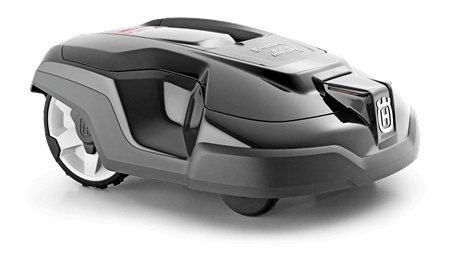50 years from now, people will look back and marvel at the fact that in 2016 we drove our own cars—the same way we marvel at our grandparents having to use a washing board rather than a laundry machine. Maybe they’ll be amazed that we mowed our own lawns, too.
Robot mowers have been around for about 20 years, but haven’t yet become popular. At time of writing, the top-selling robot lawnmower on Amazon, the Worx Landroid, has just 45 reviews. Meanwhile, the top-selling robot vacuum cleaner, the Roomba 690, has more than 3,000.
Strange, because a robot vacuum isn’t doing anything that a regular vacuum can’t. A robot mower, though, actually represents an improvement over traditional lawnmowing.

Robot Mowers Can Improve The Health Of Your Lawn
The latest models of robot lawnmower are designed to slice grass so thin that it falls back onto the lawn, where it is broken down as fertilizer. With a robot mower, which works non-stop during the growing season, you’re constantly feeding the soil, making your lawn stronger and prettier. A traditional once-weekly cut results in too much waste for the soil to truly absorb.
Robot lawnmowers are also incredibly quiet. When you watch videos of people showing off their robot mowers, they’ll often have to look around for the thing first—it’s so quiet you’ll see it well before you hear it.
The main market for robot lawnmowers are folks who pay for lawn service. With the average cost of a weekly mow around $50, you’d pay off the $999 cost of the Worx robot mower in one growing season.
You get a quieter, cheaper mow with a robot lawnmower, and one that improves the soil quality of your lawn, too. So why aren’t people buying more of them?
Related Post: Electric Lawn Mower Reviews
More than anything, it seems to be a “creepy” factor holding people back. The idea of a device constantly roaming their yard simply weirds some people out. Safety seems to be a fear—though higher-end robot mowers have features that eliminate the chance of a dangerous accident. Theft is also a concern.
And the robot mower isn’t quite as “set it and forget it” as manufacturers claim. Video reviews of the mowers reveal that they often can’t get close enough to lawn edges to keep them cut. Most homeowners will have to set aside some time to touch-up these hard to get places.
The High-End Of The Market: Husqvarna Automower
Husqvarna is a robot mower pioneer; they’ve been gradually improving their product over the last 20 years. They like to see the Automower as a holistic lawn-care system rather than just as an appliance.
The Husqvarna has some pretty cool tech. It learns how to cut your lawn over the period of a week, and memorizes your lawn’s size and obstacles using GPS.
The Husqvarna’s cutting blades aren’t fixed like those of most mowers, and some robot mower competitors. Instead, the blades pivot—they are strong enough to cut through grass, but if they hit a harder non-grass object they simply glance off of it.
The Husqvarna has impressive safety features. You can’t operate it without a PIN number, and the mower will only charge in the port that comes with it. So even if a thief had their own charging port, they wouldn’t be able to use your mower. Some of the models will even blare an alarm if they’re taken too far from their port.
The models range in price from the Automower 315, MSRP $1,999, which can cut a lawn up to .37 acres (16,000 square feet), to the Automower 450X, MSRP $3,499, which can cut a lawn up to 1.25 acres (54,500 square feet).
Husqvarna Automower is only available from Husqvarna dealers. Those dealers have a machine that install the Automower’s guidewire below-ground. Use their dealer locator to find one near you.
The Less-Expensive End Of The Market: Worx Landroid
The Worx has some of the same features as the Husqvarna—so similar, in fact, that Husqvarna sued the manufacturer of Worx for patent infringement.
The most prominent is the pivoting blade—prior to the Worx being introduced, Husqvarna’s model was the only one with this feature. Other robot mowers have fixed blades, just like any other mower. The pivoting blade is quieter, uses less energy, and won’t grind up objects it runs over.
At around $1,000 cheaper, the Worx is half the price of the Husqvarna. The money you save is going to cost you in both time and risk. We wouldn’t recommend buying one.
While a Husqvarna dealer will set up robotic mower for you, including laying the wires that guide the machine, you need to do this work yourself if you buy the Worx. Reviewers on Amazon said it took them the best part of a day, then a fair amount of troubleshooting to get the settings just right.
Amazon reviews are also replete with Worx customer service horror stories. If your machine happens to malfunction—and it seems like a high proportion Worx mowers do—you could be in for a bureaucratic nightmare and weeks of waiting to get the product working again.
Your first point of customer service contact seems to be a call center where the person is unlikely to understand much about the mower. Customers complain about long waits for parts, or never getting parts at all.
On the other hand, you may get, like many Amazon customers report, a Worx that’s in perfect working order. It’s a bit of a luck-of-the-draw situation.
First-adopters, tech fans, and grown-ups who love new toys will get a kick out of a robot mower. But so will people who care about the health of their lawn, who want a more eco-friendly mower, and who want to save money over lawn service.






































